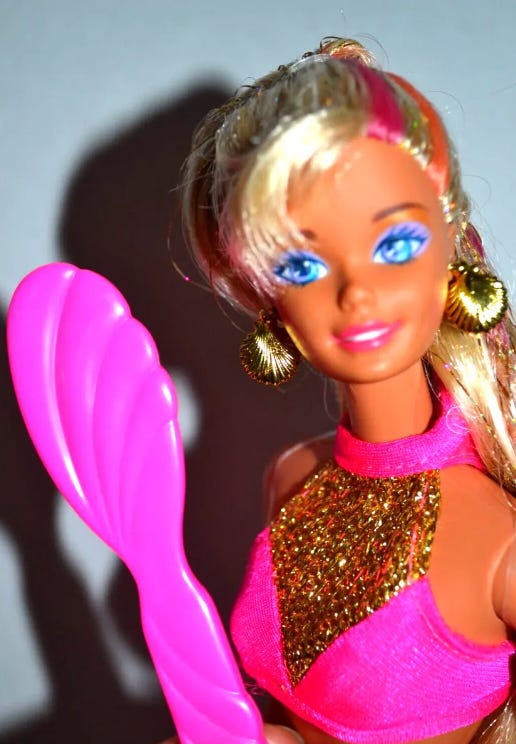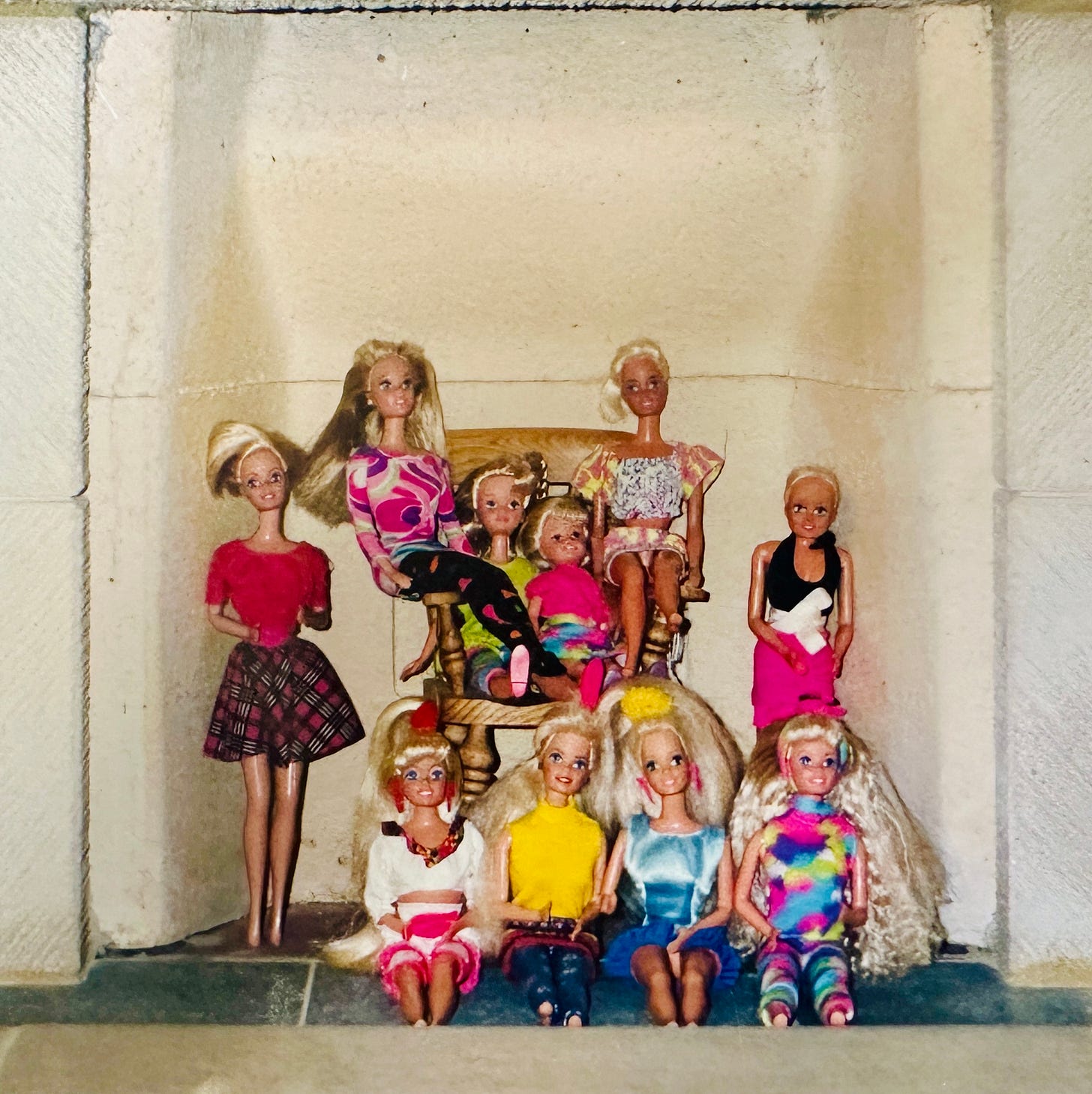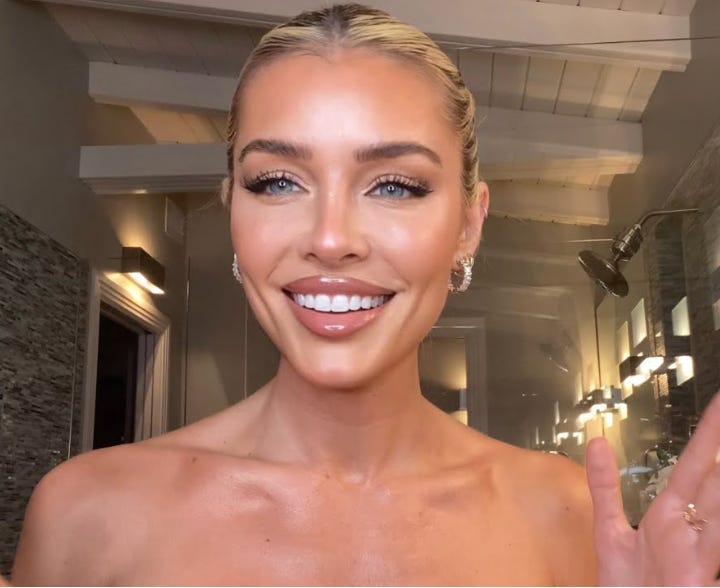I think Barbie might have ruined my life...
And I'm not sure I'll ever be able to forgive her.
I know you’re probably done with hearing ‘hot takes’ on the Barbie film. It feels like the pink, sparkly dust has finally settled and we can talk about SOMETHING ELSE again. But before that, I just want to add one final candy-hued debrief into the mix…
Prior to doing the research for my book UGLY, I was pretty indifferent about Barbie and she was merely a nostalgic figure from my youth. But as I unpacked my own relationship to beauty standards, I discovered just how much of an impact she really had on me. Because of that I’d thought I’d loathe the Barbie film, although I know director Greta Gerwig actively tried to address the lack of representation that Barbie is known for (she fought for the line about Barbie being a fascist against Mattel’s wishes for example.) But overall I chuckled, cringed and felt indifferent in equal parts.
More interesting than the film, was the fascinating conversations it sparked with my friends about their Barbie experiences; some had loads of Barbies and adored them. Some weren't allowed them on principle. Some couldn't afford them and made do with second-rate Barbies (ahem, hey Sindy) so coveted them even more. We all have our own history with Barbie, which I guess does make her iconic, but that doesn’t necessarily mean she’s an innocent party. I think we do need to hold her way more accountable than we currently do…
These were my Barbies. I found this photo when looking for pictures to introduce the chapter on childhood in my book, where I talk about the impact of toys and children's media on our early self esteem. And if I had to choose just one photo that embodies my painful journey with my appearance, then this would be it.
I was obsessed with Barbie as soon as I clapped eyes on her glamorous attire, miniscule waist, and flaxen hair. TV adverts for toys were rampant in the 80s (as was the extreme gendering of children's toys, coincidentally,) and the joy of flicking through the Argos catalogue each time a new one was released was unparalleled. PLEASE NOTE: if you were born after the internet 1) How very dare you make me feel ancient on my own Substack and 2) I jest, but honestly the new Argos catalogue drop was the pinnacle of shopping experiences back then.
Each time the new catalogue arrived I’d flick straight to the doll section to pour over the newest versions of Barbie. Sometimes she’d be a princess in a ballgown, or she’d drive a white cabriolet which was my most coveted Barbie accessory (that even came up in a fight with my parents once which is some seriously unbecoming brattiness on my part…but I was 16 to be fair.) Sometimes Barbie was a cheerleader, or maybe a showgirl, but I seldom remember seeing her as a doctor or lawyer like the film suggested.
However she looked, whatever she was doing, I loved her entirely. Her straight, silky hair captivated me the most as it felt so different to my frizzy, curly Indian hair. Her thin body, huge perky tits and tiny waist felt grown up and her outfits seemed impossibly glamorous. But in hindsight, I now realise that Barbie didn’t really love me back; I don’t think she loved many of us, actually. It does seem a tad taboo to say that, amidst the carefully curated hysteria and unbelievably smart marketing around the film, but if we’re brutally honest about it, Barbie was pivotal in helping to instil what ‘pretty’ looked like for generations of young girls.
We’re sold Barbie at a point where our self esteem and body image is at its most vulnerable, aged around six to eleven. Researchers have studied the effects of playing with very thin dolls like Barbie and Monster High - both have proportions that put them in ultra low BMI categories of 16.4, and 10 respectively - compared to more realistically proportioned dolls. The study authors found that the thinner dolls actively shifted young girls' perceptions of the ideal body shape to being ultra slim, but sadly playing with more realistic dolls afterwards didn’t erase the belief that ‘thinner is better’.
I could list reams of studies on the effects that Barbie (and dolls like her) have had on our childhood self esteem, but honestly, how many more do we need to prove that she’s not the best role model? Sadly, we don’t get a ‘grownup’ software update as adults that overrides all that early messaging, and instead those same beauty standards Barbie teaches us to prize - like thinness, whiteness and even blondeness - end up being perpetuated everywhere we look, from the girls in the teen magazines that I was reading, through to our biggest pop stars, actors, and now influencers. Tik Tok is obsessed with the ‘clean girl’ aesthetic above, but who is she if not a grown-up Barbie albeit with a smartphone, 5G and even more impossibly perfect skin?
That same doll study I mentioned earlier also showed that between the ages of six to eleven is when girls start to feel the effects of how women's bodies are objectified. Bleaker still, those who see their bodies from that perspective are at a greater risk of developing depression as teens. I can see how that timeline worked out for me and after my introduction to beauty standards via Barbie, everything I watched, read, saw and experienced prized the same beauty parameters of thinness, whiteness, hourglass shaped bodies, big boobs, and blonde hair. I was never going to achieve that and instead my journey resulted in caustically low self esteem, eating disorders and a seriously warped view of what ‘beauty’ was.
I’m not solely blaming Barbie (or anyone else I engaged with at the time) but that repeated exposure to a singular form of Eurocentric beauty did affect how I saw beauty and my own value. It’s not just about appearances either; there are other signifiers that come as a free gift with ‘being beautiful’; namely instant popularity (despite being objectively awful Regina George from Mean Girls is worshipped) and success (Cher Horowitz from Clueless was always shopping in her fancy car, just like Barbie and her stupid cabriolet I never got to own.) That subliminal messaging tells little girls that ‘this is what beautiful and successful really looks like’.
That has huge implications for us as adults when it comes to examining the unearned privileges in society that fitting into the beauty standard can potentially afford you, known as pretty privilege or lookism. Research found that blonde women are paid 7% more than women with other hair colours. Another study showed that ethnic minority workers could be earning much less than white counterparts in the same companies. And, women in the obese category tend to earn less than their thinner peers, but tellingly the same pattern doesn’t correlate to men’s salaries.
For me Barbie isn’t the feminist icon the film suggests she is and in reality she was actually a foe in an always-smiling, plastic guise. There’s so much the film glosses over, and while I applaud the directors for trying to make the film a celebration of all people, we have to remember the lingering damage that this lack of representation has had on generations of children. So when the Barbie hype dies down, we can’t lose sight of what needs to change - and we have to keep talking about it, for future generations, and our own inner child.
Side note: A few things the Barbie film glosses over…
Barbie was modelled on a fictional German sex worker…
The very direct inspiration for Barbie came from a German doll called Lilli, a comic strip character from 1952 who was a ‘high-end escort.’ Lilli dolls were sold in tobacco shops, bars, shops and given as a bit of a joke at bachelor/stag parties.
Ruth Handler (co-founder of Mattel) saw Lilli on a trip to Europe and used her as the inspiration for Barbie, then bought the rights to Lilli and discontinued that bitch. See ya Lils! Handler even admitted that Barbie was a sexy doll, but she didn’t see anything wrong with that. Hmm…
2. Barbie will always be a white gal at heart…

It wasn't until the 1980s that the first standalone Black Barbie was created by Mattel’s Principle designer Kitty Black Perkins (above) but by this point Mattel had been a company since 1945, so they took a while. Multiple studies (including the famous ‘doll tests’ from the 1950s) have shown that children of colour show a preference for white dolls because it mimics how society has always elevates whiteness and put a hierarchical value on skin colour. So, was it an oversight that there wasn’t a Black Barbie until the 1980s, or an Indian Barbie until 2022(!) or was it the lingering ghosts of white supremacy and Eurocentric beauty ideals at work instead? You decide.
3.Barbie has always had an agenda…
In 1992 Teen Talk Barbie could speak, but she didn’t use her new-found voice for good. Instead, she said things like: “Will I ever have enough clothes?”, “I love shopping!” “Party dresses are fun!” and “Math is tough!” Meanwhile in 2010 Computer Engineer Barbie was created to showcase women in STEM, but the accompanying comic-type book did the opposite; Barbie can’t fix anything without the help of her male coworkers, and seems to repeatedly infect computers with viruses. Mattel apologised four years later, but by then the brilliant #FeministHackerBarbie memes (example above) had gone viral, so she did something right I guess?
Barbie has done her fair amount of fat shaming too. Babysitter Barbie from 1963 came with some questionable reading material, namely a book entitled ‘DON’T EAT!’ (a pretty short read one might imagine.) But to really hammer that message home Sleepover Barbie, released a couple of years later, came with a book titled ‘How to lose weight’ and a set of scales set to be 35lbs underweight for a 5”9 woman (which is Barbie's ‘real-life’ height, FYI.)
Maybe if Barbie HAD eaten something, she might have had enough brain power to fix her own computer? Just a thought…













I think for little me, there was an element of prestige associated with playing with my Barbies because Barbie was an extension of the majority of female protagonists in film/tv/music I loved (Sailor Moon, Lizzie McGuire, Baby Spice etc). It’s sad that the value on Eurocentric physicalities being the pillar of beauty were hammered home super early. Even the clean girl good look’s popularity is perplexing. Brown women have been oiling their hair and tying in buns forever but it was looked down on. Now that white female influencers do it, it’s a whole aesthetic. Very reminiscent of the west subordinating the east but that’s a whole other conversation. Thanks for the post Anita. I enjoyed it!
This is such a complex topic but the bottom line is that lauding the characteristics Barbie has is damaging. My kids played with dolls (only the odd Barbie) and I encouraged it as a means of preserving their innocence when they were young and their Tom Boy peers and their parents laughed at them for it at the time, only for those girls to quickly adopt aged ten onwards the Barbie look and dying their hair blonde and more. There is a really important parenting conversation to be had around this as a lot of the behaviour by young girls chasing the Barbie look is actively encouraged by parents. It's not just Barbie these kids are following but it starts with Barbie. Separately as a woman of colour I'm watching in amazement as to how many women of my ethnicity are dying their hair blonde. In the workplace it doesn't take long to figure out that many women CEOs happen to be white with blonde hair - people should have have agency over hair colour but we can't deny that it looks like dying your hair blonde would probably be a good career option.